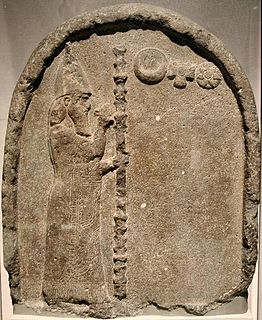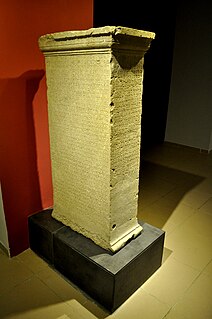 W
WThe Babylonian Chronicles are a series of tablets recording major events in Babylonian history. They are thus one of the first steps in the development of ancient historiography. The Babylonian Chronicles were written in Babylonian cuneiform, from the reign of Nabonassar up to the Parthian Period, by Babylonian astronomers ("Chaldaeans"), who probably used the Astronomical Diaries as their source.
 W
WThe Babylonian revolts of 484 BC were revolts of two rebel kings of Babylon, Bel-shimanni and Shamash-eriba, against Xerxes I, king of the Persian Achaemenid Empire.
 W
WThe Battle of Opis, fought in September 539 BC, was a major engagement between the armies of Persia under Cyrus the Great and the Neo-Babylonian Empire under Nabonidus during the Persian invasion of Mesopotamia. At the time, Babylonia was the last major power in western Asia that was not yet under Persian control. The battle was fought in or near the strategic riverside city of Opis, north of the capital Babylon. It resulted in a decisive victory for the Persians. A few days later, the city of Sippar surrendered to the Persians and Cyrus's forces entered Babylon apparently without a fight. Cyrus was subsequently proclaimed king of Babylonia and its subject territories, thus ending the independence of Babylon and incorporating the Babylonian Empire into the greater Persian Empire.
 W
WBel-Shalti-Nanna or Bel-Shalti-Nannar, named also Ennigaldi-Nanna, was a Babylonian princess who flourished around 554 BCE. She was the daughter of Nabonidus (Nabu-na'id), the last Neo-Babylonian king and ruler of the city of Ur, and sister of Belshazzar. She served as a high priestess in Ur. She was called the "priestess of Sin".
 W
WThe Chaldean dynasty, also known as the Neo-Babylonian dynasty and enumerated as Dynasty X of Babylon, was the ruling dynasty of the Neo-Babylonian Empire, ruling as kings of Babylon from the ascent of Nabopolassar in 626 BC to the fall of Babylon in 539 BC. The dynasty, as connected to Nabopolassar through descent, was deposed in 560 BC by the Aramean official Neriglissar, though he was connected to the Chaldean kings through marriage and his son and successor, Labashi-Marduk, might have reintroduced the bloodline to the throne. The final Neo-Babylonian king, Nabonidus, was genealogically unconnected to the previous kings, but might, like Neriglissar, also have been connected to the dynasty through marriage.
 W
WThe Fall of Babylon denotes the end of the Neo-Babylonian Empire after it was conquered by the Achaemenid Empire in 539 BCE. Historians also use the term Liberation of Babylonia interchangeably.
 W
WImperial Aramaic is a linguistic term, coined by modern scholars in order to designate a specific historical variety of Aramaic language. The term is polysemic, with two distinctive meanings, wider (sociolinguistic) and narrower (dialectological).
 W
WThe Medo-Babylonian conquest of the Assyrian Empire was the last war fought by the Neo-Assyrian Empire between 626 and 609 BC. Succeeding his brother Ashur-etil-ilani, the new king of Assyria, Sinsharishkun, was immediately faced by the revolt of one of his brother's chief generals, Sin-shumu-lishir, who attempted to usurp the throne for himself. Though this threat was dealt with relatively quickly, the instability caused by the brief civil war may have made it possible for another official or general, Nabopolassar, to rise up and seize power in Babylonia. Sinsharishkun's inability to defeat Nabopolassar, despite repeated attempts over the course of several years, allowed Nabopolassar to consolidate power and form the Neo-Babylonian Empire, restoring Babylonian independence after more than a century of Assyrian rule. The Neo-Babylonian Empire, and the newly formed Median Empire under King Cyaxares, then invaded the Assyrian heartland. In 614, the Medes captured and sacked Assur, the ceremonial and religious heart of the Assyrian Empire, and in 612 their combined armies attacked and razed Nineveh, the Assyrian capital. Sinsharishkun's fate is unknown but it is assumed that he died in the defense of his capital. He was succeeded as king only by Ashur-uballit II, possibly his son, who rallied what remained of the Assyrian army at the city of Harran and, bolstered by an alliance with Egypt, ruled for three years, in a last attempt to resist the Medo-Babylonian invasion of his realm.
 W
WThe Nabonidus Chronicle is an ancient Babylonian text, part of a larger series of Babylonian Chronicles inscribed in cuneiform script on clay tablets. It deals primarily with the reign of Nabonidus, the last king of the Neo-Babylonian Empire, covers the conquest of Babylon by the Persian king Cyrus the Great, and ends with the start of the reign of Cyrus's son Cambyses, spanning a period from 556 BC to some time after 539 BC. It provides a rare contemporary account of Cyrus's rise to power and is the main source of information on this period; Amélie Kuhrt describes it as "the most reliable and sober [ancient] account of the fall of Babylon."
 W
WThe Neo-Babylonian Empire, also known as the Second Babylonian Empire and historically known as the Chaldean Empire, was the last of the Mesopotamian empires to be ruled by monarchs native to Mesopotamia. Beginning with Nabopolassar's coronation as King of Babylon in 626 BC and being firmly established through the fall of the Neo-Assyrian Empire in 612 BC, the Neo-Babylonian Empire and its ruling Chaldean dynasty would be short-lived, being conquered after less than a century by the Persian Achaemenid Empire in 539 BC.
 W
WNitocris of Babylon is an otherwise unknown queen of Babylon described by Herodotus in his Histories. According to Herodotus she was the wife of Nabonidus against whose son Cyrus the Great launched an expedition. Dougherty and Beaulieu identify the son as Belshazzar. If this is the case, she is most likely the queen in the story of Belshazzar's feast, and she is identified as such in Handel's oratorio Belshazzar.